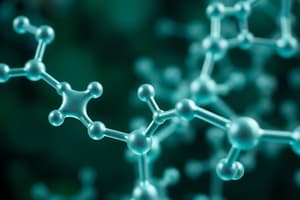Podcast
Questions and Answers
Draw the generalized structure of an amino acid.
Draw the generalized structure of an amino acid.
N/A
Label the amine group, alpha carbon, and R group on an amino acid.
Label the amine group, alpha carbon, and R group on an amino acid.
N/A
State the number of amino acids used by living organisms to make polypeptides.
State the number of amino acids used by living organisms to make polypeptides.
20
Given an image of an amino acid, classify the amino acid chemical properties based on R group properties.
Given an image of an amino acid, classify the amino acid chemical properties based on R group properties.
Explain the trend of organisms assembling polypeptides from the same amino acids.
Explain the trend of organisms assembling polypeptides from the same amino acids.
Describe a discrepancy in the trend of all organisms using the same amino acids to assemble polypeptides.
Describe a discrepancy in the trend of all organisms using the same amino acids to assemble polypeptides.
Outline the concept of 'conditionally essential' using amino acid examples.
Outline the concept of 'conditionally essential' using amino acid examples.
Define 'essential' as related to dietary nutrients.
Define 'essential' as related to dietary nutrients.
Define 'non-essential' as related to dietary nutrients.
Define 'non-essential' as related to dietary nutrients.
Outline the effect of protein deficiency malnutrition on children and adults.
Outline the effect of protein deficiency malnutrition on children and adults.
Describe the primary structure of a protein, including the type of bonding involved.
Describe the primary structure of a protein, including the type of bonding involved.
Outline the relationship between genes and polypeptides.
Outline the relationship between genes and polypeptides.
Describe polypeptide chain formation in terms of the formation of peptide bonds and condensation reactions.
Describe polypeptide chain formation in terms of the formation of peptide bonds and condensation reactions.
Draw peptide bond formation in a condensation reaction.
Draw peptide bond formation in a condensation reaction.
Calculate the possible number of amino acid sequences given n number of amino acids.
Calculate the possible number of amino acid sequences given n number of amino acids.
Describe the secondary structure of a protein, including the type of bonding involved.
Describe the secondary structure of a protein, including the type of bonding involved.
Identify the alpha-helix and beta-pleated sheet in images of protein structure.
Identify the alpha-helix and beta-pleated sheet in images of protein structure.
Describe the tertiary structure of a protein, including the types of R group interactions involved.
Describe the tertiary structure of a protein, including the types of R group interactions involved.
Explain how the chemical characteristics of R groups in the polypeptide chain affect protein folding.
Explain how the chemical characteristics of R groups in the polypeptide chain affect protein folding.
Contrast the structure of globular proteins with the structure of fibrous proteins.
Contrast the structure of globular proteins with the structure of fibrous proteins.
Describe the structure of membrane-bound globular proteins.
Describe the structure of membrane-bound globular proteins.
Outline the structure and function of three example proteins composed of two.
Outline the structure and function of three example proteins composed of two.
Flashcards are hidden until you start studying
Study Notes
Amino Acids
- Generalized structure includes an amine group, alpha carbon, and carboxylic acid group.
- Organisms use 20 standard amino acids to synthesize polypeptides.
- Some amino acids can be categorized based on their R group properties.
Protein Synthesis
- Most organisms utilize the same 20 amino acids for protein assembly, showcasing a universal trend.
- Variations exist; historically, other amino acids may have been leveraged if accessible.
- Natural selection favors the use of these 20 amino acids for their ability to produce a diverse range of proteins.
Essential and Non-Essential Amino Acids
- "Conditionally essential" amino acids may be vital under specific conditions, such as growth phases or during illness.
- Essential nutrients cannot be synthesized by the body and must be obtained from the diet.
- Non-essential nutrients can be synthesized by the body or replaced with alternative nutrients.
Malnutrition Effects
- Protein deficiency can result in malnutrition, manifested in symptoms like hair loss and pigmentation issues due to a lack of essential amino acids.
Protein Structure
- The primary structure of a protein is defined by peptide bonds, a type of covalent bond.
- Polypeptides are formed through condensation reactions, creating peptide bonds between adjacent amino acids.
- The relationship between genes and polypeptides follows the sequence: DNA → RNA → protein; gene sequences convert into polypeptide sequences.
Structural Levels of Proteins
- Secondary structure formation is stabilized by hydrogen bonds between amino acids.
- Tertiary structure refers to the overall 3D shape, influenced by R group interactions, including hydrophobic interactions, ionic bonds, hydrogen bonds, and disulfide bridges.
- Folding of proteins is dictated by the R group characteristics, affecting size, polarity, and pH.
Types of Protein Structures
- Globular proteins feature a tertiary structure with hydrophilic amino acids on the exterior and hydrophobic amino acids tucked inside, promoting water solubility.
- Fibrous proteins have contrasting structures, typically elongated and insoluble.
Calculations and Models
- The potential number of amino acid sequences can be represented by the formula 20^n, where n is the number of amino acids in the sequence.
Studying That Suits You
Use AI to generate personalized quizzes and flashcards to suit your learning preferences.




